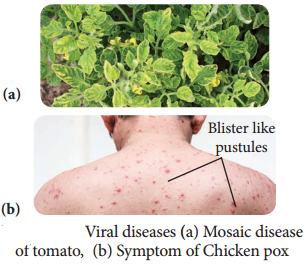Learninsta presents the core concepts of Biology with high-quality research papers and topical review articles.
Viruses – Definition | Structure | Various Types of Viruses and its Function
Did you go through the headlines of newspapers in recent times? Have you heard of the terms EBOLA, ZIKA, AIDS, SARS, H1N1 etc.? There are serious entities which are considered as “Biological Puzzle” and cause disease in man. They are called viruses. We have learnt about the attributes of living world in the previous chapter. Now we shall discuss about viruses which connect the living and nonliving world.
The word virus is derived from Latin meaning ‘Poison’. Viruses are submicroscopic, obligate intracellular parasites. They have nucleic acid core surrounded by protein coat. Viruses in their native state contain only a single type of nucleic acid which may be either DNA or RNA. The study of viruses is called Virology.
Milestones in Virology
- 1796 – Edward Jenner used vaccination for small pox
- 1886 – Adolf Mayer demonstrated the infectious nature of Tobacco mosaic virus using sap of mosaic leaves
- 1892 – Dimitry Ivanowsky proved that viruses are smaller than bacteria
- 1898 – M.W. Beijierink defined the infectious agent in tobacco leaves as ‘Contagium vivum fluidum’
- 1915 – F.W.T wort identified Viral infection in Bacteria
- 1917 – d’Herelle coined the term ‘Bacteriophage’
- 1984 – Luc Montagnier and Robert Gallo discovered HIV (Human Immuno Deficiency Virus).
Size and Shape
Viruses are ultramicroscopic particles. They are smaller than bacteria and their diameter range from 20 to 300 nm. (1nm = 10-9 metres). Bacteriophage measures about 10-100 nm in size. The size of TMV is 300×20 nm.
Generally viruses are of three types based on shape and symmetry (Figure 1.4).
- Cuboid Symmetry – Example: Adenovirus, Herpes virus.
- Helical Symmetry – Example: Influenza virus, TMV.
- Complex or Atypical – Example: Bacteriophage, Vaccinia virus.
Characteristic Features of Viruses
Living Characters
- Presence of nucleic acid and protein
- Capable of mutation
- Ability to multiply within living cells
- Able to infect and cause diseases in living beings
- Show irritability
- Host – specific
Non-living Characters
- Can be crystallized
- Absence of metabolism
- Inactive outside the host
- Do not show functional autonomy
- Energy producing enzyme system is absent
Classification of Viruses
Among various classifications proposed for viruses the classification given by David Baltimore in the year 1971 is given below. The classification is based on mechanism of RNA production, the nature of the genome (single stranded – ss or double stranded – ds), RNA or DNA, the use of reverse transcriptase (RT), ss RNA may be (+) sense or (–) antisense. Viruses are classified into seven classes (Table 1.2).
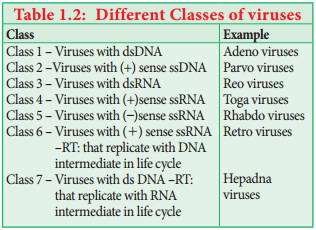
Viral Genome
Each virus possesses only one type of nucleic acid either DNA or RNA. The nucleic acid may be in a linear or circular form. Generally nucleic acid is present as a single unit but in wound tumour virus and in influenza virus it is found in segments. The viruses possessing DNA are called ‘Deoxyviruses’ whereas those possessing RNA are called ‘Riboviruses’.
Majority of animal and bacterial viruses are DNA viruses (HIV is the animal virus which possess RNA). Plant viruses generally contain RNA (Cauliflower Mosaic virus possess DNA). The nucleic acids may be single stranded or double stranded. On the basis of nature of nucleic acid viruses are classified into four Categories. They are Viruses with ssDNA (Parvo viruses), dsDNA (Bacteriophages), ssRNA (TMV) and dsRNA(Wound Tumour Virus).
Tobacco Mosaic Virus (TMV)
Tobacco mosaic virus was discovered in 1892 by Dimitry Ivanowsky from the Tobacco plant. Viruses infect healthy plants through vectors like aphids, locusts etc. The first visible symptom of TMV is discoloration of leaf colour along the veins and show typical yellow and green mottling which is the mosaic symptom. The downward curling and distortion of young apical leaves occurs, plant becomes stunted and yield is affected.
Structure
Electron microscopic studies have revealed that TMV is a rod shaped (Figure 1.4b) helical virus measuring about 300x20nm with a molecular weight of 39×106 Daltons. The virion is made up of two constituents, a protein coat called capsid and a core called nucleic acid.
The protein coat is made up of approximately 2130 identical protein subunits called capsomeres which are present around a central single stranded RNA molecule. The genetic information necessary for the formation of a complete TMV particle is contained in its RNA. The RNA consists of 6,500 nucleotides.
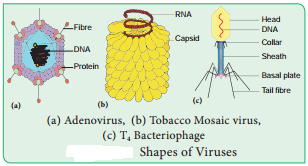
Bacteriophage
Viruses infecting bacteria are called Bacteriophages. It literally means ‘eaters of bacteria’ (Gr: Phagein = to eat). Phages are abundant in soil, sewage water, fruits, vegetables, and milk.
Structure of T4 Bacteriophage
The T4 phage is tadpole shaped and consists of head, collar, tail, base plate and fibres (Figure 1.4). The head is hexagonal which consists of about 2000 identical protein subunits. The long helical tail consists of an inner tubular core which is connected to the head by a collar.
There is a base plate attached to the end of tail. The base plate contains six spikes and tail fibres. These fibres are used to attach the phage on the cell wall of bacterial host during replication. A dsDNA molecule of about 50 µm is tightly packed inside the head. The DNA is about 1000 times longer than the phage itself.
Multiplication or Life Cycle of Phages
Phages multiply through two different types of life cycle. a. Lytic or Virulent cycle b. Lysogenic or Avirulent life cycle.
a. Lytic Cycle
During lytic cycle of phage, disintegration of host bacterial cell occurs and the progeny virions are released (Figure 1.5 a). The steps involved in the lytic cycle are as follows:
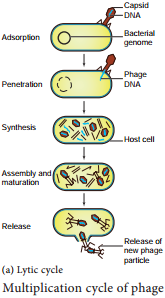
(i) Adsorption
Phage (T4) particles interact with cell wall of host (E. coli). The phage tail makes contact between the two, and tail fibres recognize the specific receptor sites present on bacterial cell surface. The lipopolysaccharides of tail fibres act as receptor in phages.
The process involving the recognition of phage to bacterium is called landing. Once the contact is established between tail fibres and bacterial cell, tail fibres bend to anchor the pins and base plate to the cell surface. This step is called pinning.
(ii) Penetration
The penetration process involves mechanical and enzymatic digestion of the cell wall of the host. At the recognition site phage digests certain cell wall structure by viral enzyme (lysozyme). After pinning the tail sheath contracts (using ATP) and appears shorter and thicker.
After contraction of the base plate enlarges through which DNA is injected into the cell wall without using metabolic energy. The step involving injection of DNA particle alone into the bacterial cell is called Transfection. The empty protein coat leaving outside the cell is known as ‘ghost’.
(iii) Synthesis
This step involves the degradation of bacterial chromosome, protein synthesis and DNA replication. The phage nucleic acid takes over the host biosynthetic machinery. Host DNA gets inactivated and breaks down. Phage DNA suppresses the synthesis of bacterial protein and directs the metabolism of the cell to synthesis the proteins of the phage particles and simultaneously replication of Phage DNA also takes place.
(iv) Assembly and Maturation
The DNA of the phage and protein coat are synthesized separately and are assembled to form phage particles. The process of assembling the phage particles is known as maturation. After 20 minutes of infection, about 300 new phages are assembled.
(v) Release
The phage particle gets accumulated inside the host cell and are released by the lysis of host cell wall.
b. Lysogenic Cycle
In the lysogenic cycle the phage DNA gets integrated into host DNA and gets multiplied along with nucleic acid of the host. No independent viral particle is formed (Figure 1.5 b).
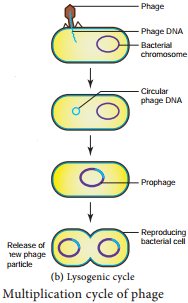
As soon as the phage injects its linear DNA into the host cell, it becomes circular and integrates into the bacterial chromosome by recombination. The integrated phage DNA is now called prophage. The activity of the prophage gene is repressed by two repressor proteins which are synthesized by phage genes. This checks the synthesis of new phages within the host cell. However, each time the bacterial cell divides, the prophage multiplies along with the bacterial chromosome.
On exposure to UV radiation and chemicals the excision of phage DNA may occur and results in lytic cycle. Virion is an intact infective virus particle which is non-replicating outside a host cell.
Viroid is a circular molecule of ssRNA without a capsid and was discovered by T.O.Diener in the year 1971. The RNA of viroid has low molecular weight. Viroids cause citrus exocortis and potato spindle tuber disease in plants.
Virusoids were discovered by J.W.Randles and Co-workers in 1981. They are the small circular RNAs which are similar to viroids but they are always linked with larger molecules of the viral RNA.
Prions were discovered by Stanley B. Prusiner in the year 1982 and are proteinaceous infectious particles. They are the causative agents for about a dozen fatal degenerative disorders of the central nervous system of humans and other animals. For example Creutzfeldt – Jakob Disease (CJD), Bovine Spongiform Encephalopathy (BSE) – commonly known as mad cow disease and scrapie disease of sheep.
Viral Diseases
Viruses are known to cause disease in plants, animals and Human beings (Figure 1.6). A list of viral disease is given in Table 1.3.
